
International Journal of Ventilation
Scope & Guideline
Advancing Sustainable Solutions in Engineering
Introduction
Aims and Scopes
- Ventilation System Design and Optimization:
Research on the design and optimization of various ventilation systems, including passive, hybrid, and mechanical systems, to enhance their efficiency and effectiveness in different building types. - Indoor Air Quality (IAQ) Assessment:
Studies that focus on measuring and improving indoor air quality through various ventilation strategies, including the evaluation of pollutants, ventilation rates, and health impacts on occupants. - Thermal Comfort and Energy Performance:
Investigations into the relationship between ventilation strategies and thermal comfort, as well as energy performance of buildings, including the use of heat recovery systems and the impacts of building parameters. - Numerical and Experimental Modeling:
Utilization of computational fluid dynamics (CFD) and experimental methods to simulate airflow patterns, pollutant dispersion, and thermal dynamics in ventilated spaces. - Ventilation in Special Environments:
Research addressing unique ventilation challenges in specialized environments such as hospitals, transportation systems, and extreme climate conditions.
Trending and Emerging
- Health Impact Assessments of Ventilation Systems:
An increasing number of studies are assessing the health impacts of different ventilation strategies, particularly in relation to indoor air contaminants and their effects on occupant well-being. - Sustainable and Energy-Efficient Ventilation Solutions:
There is a growing focus on developing ventilation systems that contribute to sustainable building practices, including energy recovery systems and passive design strategies that minimize energy consumption. - Smart Ventilation and Technology Integration:
The integration of smart technologies and IoT in ventilation systems is emerging as a key trend, with research exploring automated control systems and their impact on IAQ and energy efficiency. - Ventilation Challenges in Climate Change Scenarios:
Research addressing how ventilation systems can adapt to the challenges posed by climate change, including increased temperatures and extreme weather events, is becoming more prominent. - Experimental Validation of Simulation Models:
A strong trend towards validating numerical models through experimental studies is evident, emphasizing the importance of accurate simulations for predicting ventilation performance in real-world scenarios.
Declining or Waning
- Historical and Traditional Ventilation Techniques:
There has been a noticeable decline in papers focusing on historical or traditional ventilation methods, as the journal shifts towards more contemporary and innovative approaches to ventilation. - Ventilation in Non-Building Environments:
Research related to ventilation systems in non-building contexts, such as outdoor air quality or agricultural settings, seems to be diminishing, possibly due to a greater emphasis on indoor environments. - Basic Theoretical Studies:
The journal has seen fewer purely theoretical studies without practical applications or experimental validation, indicating a trend towards more applied research that addresses current ventilation challenges.
Similar Journals

International Journal of Heat and Technology
Connecting Academia and Industry through Heat ResearchThe International Journal of Heat and Technology is a premier academic publication dedicated to the dissemination of innovative research in the fields of thermal engineering, fluid mechanics, and condensed matter physics. Published by the INT INFORMATION & ENGINEERING TECHNOLOGY ASSOCIATION and based in Italy, this journal has been a significant resource for researchers and professionals since its inception in 1983, with a commitment to advancing knowledge until 2024. With an impact factor that reflects its relevance, the journal encompasses diverse topics within its scope, bridging gaps between theoretical research and practical applications. Although currently not open access, the journal provides valuable insights into the nuances of heat transfer, flow dynamics, and material properties, making it a critical reference for academia and industry alike. The journal's Scopus rankings position it within the competitive landscape of chemical and mechanical engineering, highlighting its contribution to advancing these fields. We invite scholars, professionals, and students to engage with the rich content provided within its pages, to foster a deeper understanding of heat and technology in our rapidly evolving world.
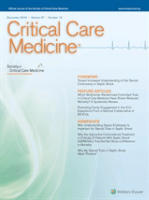
CRITICAL CARE MEDICINE
Leading the Charge in Critical Care InnovationsCRITICAL CARE MEDICINE is a premier journal dedicated to the advancement of knowledge and practice in the field of critical care and intensive care medicine. Published by Lippincott Williams & Wilkins, this distinguished journal has been at the forefront of medical research since its inception in 1973, and it continues to offer insights into the latest developments and innovations in critical care. With a remarkable ranking of #5 out of 110 in Scopus' Critical Care category and a 95th percentile rating, CRITICAL CARE MEDICINE is a leading source for high-impact research, reviews, and clinical studies. The journal is recognized as a Q1 publication, underscoring its authoritative presence within the academic community. Researchers and clinicians are encouraged to engage with cutting-edge findings that aim to improve patient care and outcomes. Although the journal is not open access, it remains an essential resource for professionals seeking to enhance their understanding and application of critical care practices.

INTERNATIONAL JOURNAL OF HEAT AND FLUID FLOW
Exploring Innovations in Thermal and Fluid SystemsFounded in 1979, the INTERNATIONAL JOURNAL OF HEAT AND FLUID FLOW is a premier publication in the fields of mechanical engineering, fluid dynamics, and heat transfer, published by Elsevier Science Inc. With an impressive impact factor and ranking in the Q1 category for Mechanical Engineering and Q2 for Condensed Matter Physics and Fluid Flow and Transfer Processes, this journal is highly regarded for its rigorous peer-reviewed articles that contribute significantly to the advancement of knowledge in these critical areas. Researchers, professionals, and students can access cutting-edge studies that explore the intricacies of thermal and fluid systems, ensuring they stay at the forefront of scientific exploration. The Scopus rankings further affirm its role as a leading source of impactful research, with significant placements in crucial academic categories. Join an active community of scholars committed to innovation and excellence in the exploration of heat and fluid flow phenomena.
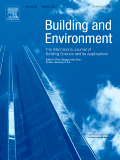
BUILDING AND ENVIRONMENT
Pioneering insights into energy-efficient design and development.BUILDING AND ENVIRONMENT, published by Pergamon-Elsevier Science Ltd, stands as a premier journal in the fields of Building and Construction, Civil and Structural Engineering, Environmental Engineering, and Geography, Planning, and Development. With its ISSN 0360-1323 and E-ISSN 1873-684X, this esteemed publication has garnered significant acclaim, achieving a Q1 ranking in multiple categories for 2023, reflecting its influential role in advancing research and innovation within these domains. Spanning from 1976 to 2024, the journal invites contributions that explore the intersection of sustainable design, energy efficiency, and urban development, addressing critical issues faced in modern architecture and environmental impact. Although it does not offer open access, its comprehensive articles and reviews are pivotal for researchers, professionals, and students dedicated to creating sustainable built environments. Situated in the United Kingdom, the journal serves as a vital resource for those aiming to contribute to the knowledge base in this rapidly evolving ecologically focused field.

Building Simulation
Pioneering Research for Energy-Conscious ConstructionBuilding Simulation is a leading academic journal published by TSINGHUA UNIVERSITY PRESS, focusing on the critical intersection of building and construction and energy efficiency. With its ISSN 1996-3599 and E-ISSN 1996-8744, this journal stands out in the Q1 category for both Building and Construction and Energy (miscellaneous), as recognized in the latest 2023 category quartiles. It has established itself as an influential platform for disseminating innovative research and developments in building performance simulation and energy use optimization, boasting impressive Scopus rankings at Rank #15/223 in Engineering (Building and Construction) and Rank #15/78 in Energy (miscellaneous), placing it in the upper percentiles of its field. Since its inception in 2008, the journal has fostered a rich dialogue among practitioners, researchers, and students, empowering them to advance sustainable building practices and contribute to global energy conservation efforts. Building Simulation is an open-access journal, making its valuable content accessible to a worldwide audience, further enhancing its role as a vital resource in the quest for innovative building solutions.
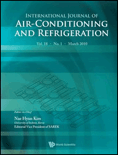
International Journal of Air-Conditioning and Refrigeration
Connecting Researchers to Transform Cooling TechnologiesInternational Journal of Air-Conditioning and Refrigeration is a leading peer-reviewed journal published by SpringerNature, focusing on pioneering research in the fields of air-conditioning and refrigeration technologies. With an Open Access model adopted since 2022, the journal ensures that high-quality research is freely accessible to a broad audience, facilitating knowledge dissemination and innovation. The journal covers a diverse range of topics, including control systems, fluid flow, and renewable energy applications, making it relevant for professionals and researchers within the disciplines of Control and Systems Engineering, Fluid Flow and Transfer Processes, and Renewable Energy. Positioned in the Q3 quartile across multiple categories as of 2023, it offers a valuable platform for emerging trends and sustainable practices in the industry. The Scopus rankings reflect its commitment to scholarly excellence, highlighting its role as an essential resource for those engaged in the development and implementation of innovative air-conditioning and refrigeration systems.

JOURNAL OF ENHANCED HEAT TRANSFER
Elevating Standards in Mechanical Engineering and Fluid DynamicsThe JOURNAL OF ENHANCED HEAT TRANSFER, published by BEGELL HOUSE INC, is a prominent resource for researchers and professionals in the fields of mechanical engineering, fluid flow and transfer processes, and condensed matter physics. With a history spanning from 1993 to 2024, this journal offers a platform for disseminating cutting-edge research and innovations that enhance our understanding of heat transfer phenomena. Although it operates under a traditional subscription model, its impressive standing is underscored by its Scopus rankings—positioned within the 59th percentile for Mechanical Engineering and 58th percentile for Fluid Flow and Transfer Processes. Additionally, it holds Q2 and Q3 categorizations in relevant fields, reflecting its importance in advancing knowledge and applications in heat transfer technology. This journal effectively bridges the gap between theoretical insights and practical solutions, making it an indispensable tool for academics, industrial practitioners, and students eager to explore advancements in thermal management and efficiency.
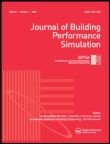
Journal of Building Performance Simulation
Driving Excellence in Building Performance and Design InnovationJournal of Building Performance Simulation, published by Taylor & Francis Ltd, is a premier academic journal dedicated to advancing the fields of architecture, building and construction, and computational modeling. With an ISSN of 1940-1493 and an E-ISSN of 1940-1507, this journal is recognized for its high-quality, peer-reviewed research, reflected in its impressive Q1 ranking in both Architecture and Building and Construction categories for 2023. Spread over a notable converged publishing timeline from 2008 to 2024, it aims to address contemporary issues in building performance and simulation methodologies, serving both practitioners and academics alike. Positioned within the 92nd percentile in Engineering - Architecture, the journal is a vital resource for professionals focused on innovative design and simulation technologies that enhance building efficiency and sustainability. Despite its robust reputation, the journal currently does not offer open-access options, which underscores its commitment to maintaining academic rigor. Engage with cutting-edge research that drives the future of building performance through this influential journal.

Journal of Green Building
Fostering Innovations in Eco-Conscious ArchitectureJournal of Green Building, with its ISSNs 1552-6100 and 1943-4618, is a premier academic journal published by COLLEGE PUBLISHING in the United States. This journal, established in 2006 and continuing through 2024, serves as a vital platform for the dissemination of research on sustainable architecture, building technologies, and environmental design. With its current impact factor signifying a robust academic contribution, it is categorized in Q2 in Architecture and Q3 across several other disciplines, including Building and Construction, Environmental Engineering, and Public Health. The journal’s Scopus rankings demonstrate its strong positioning in the engineering and environmental science communities, making it an essential resource for researchers and professionals aiming to advance knowledge in green building practices. While it is not an Open Access journal, the rich content is pivotal for those involved in the critical intersection of sustainability and construction science. Whether you are a seasoned professional or a dedicated student, the Journal of Green Building offers invaluable insights that drive future innovations in eco-friendly building environments.
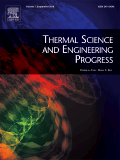
Thermal Science and Engineering Progress
Fostering collaboration for groundbreaking thermal solutions.Thermal Science and Engineering Progress is a premier peer-reviewed journal published by ELSEVIER, established to bridge the gap between theoretical and practical advancements within the fields of thermal science and engineering. Since its inception in 2017, this esteemed journal has rapidly ascended to a Q1 ranking in the category of Fluid Flow and Transfer Processes, positioning it among the top 17 of 96 journals in this discipline, as reflected by its impressive 82nd percentile ranking in Scopus. With a focus on disseminating high-impact research, Thermal Science and Engineering Progress aims to foster innovation and collaboration by publishing cutting-edge studies that address both contemporary challenges and future directions in thermal management, energy conversion, and heat transfer technologies. Researchers, professionals, and students alike are invited to explore the wealth of knowledge contained within its pages, which are accessible from its headquarters in Amsterdam, Netherlands. This journal plays a critical role in advancing technological progress and fostering a deeper understanding of thermal processes, making it an essential resource for anyone dedicated to these crucial areas of study.